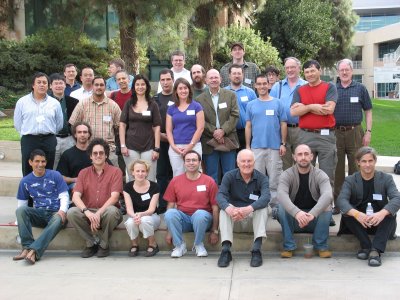Groupoidfest 08 - A Brief Report
Posted by John Baez
There were a lot of interesting talks at last weekend’s Groupoidfest here at Riverside. However, due to a lack of organization and shortage of time on my part, I can give only a brief report.
I especially enjoyed Weinstein’s talk on the volume of a differentiable stack. Someday these ideas will lead to great things. I’d heard him explain them before, but they sunk in deeper this time. I’ll try to explain someday in This Week’s Finds. In the meantime, try his paper.
Xiang Tang’s talk on group extensions and duality for gerbes was also very interesting, since it started with a review of the ‘Mackey machine’ for studying induced group representations, and then generalized this in exciting ways. Unfortunately, it zipped by too fast for me to fully understand. This wasn’t his fault: he only had 20 minutes! He hasn’t written up this work yet, so we’ll just have to wait.
I’m also happy to say that thanks to a talk by John Quigg, I’m no longer terrified of ‘Fell bundles’.
To work your way towards Fell bundles, first you should ask “If a monoid is a category with one object, what’s a C*-algebra?” The answer: “It’s a C*-category with one object!” But now suppose we want to think of a C*-category made into a kind of ‘vector bundle’ over a Lie groupoid — with the same objects, just different morphisms. This is a Fell bundle.
Some special cases may help. A Fell bundle over the terminal groupoid is just a C*-algebra. A Fell bundle over a topological group is sometimes called a “C*-algebraic bundle”. It’s a bundle of Banach spaces over the group, along with a multiplication that makes it act a lot like a C*-algebra.
But let me try to actually define a Fell bundle!
A Fell bundle starts out being a topological groupoid and a bundle of Banach spaces over the space of morphisms of :
Let be the Banach space over the morphism . Then, we equip with composition maps
that are associative and unital. This makes into a category over . In other words, we now have a category with , and gets promoted to a functor
Then we demand that be a continuous functor between topological categories. Then we demand that be a C*-category, and demand that be a -functor.
I hope the definition I’ve just given matches the standard one. I’ve tried to make it more ‘conceptual’ — that is, build it out of ideas rather than lists of equations. But I hope it could be polished further.
There were also some tantalizing talks on Lie groupoids in discrete-time mechanics and discrete field theories — especially gauge theories and nonlinear sigma-models — by Joris Vankerschaver and Melvin Leok. Someday this work should fit very nicely into Urs Schreiber’s grand plan to treat physics -categorically in such an abstract way that we can make spacetime either discrete or continuous as a kind of afterthought.
There were also three talks on groupoidification. My student Christopher Walker introduced the basic machinery:
- Christopher Walker, Groupoidified linear algebra.
Alex Hoffnung explained the application to Hecke algebras:
- Alex Hoffnung, A categorification of Hecke algebras.
I gave an overview focusing on the oldest application: the harmonic oscillator. I didn’t use slides, but this paper will eventually cover everything I said:
- John Baez, Alex Hoffnung and Christopher Walker, Groupoidification made easy.
Jeffrey Morton spoke about his new paper, which opens up a big new branch of the groupoidification program. He showed how to turn groupoids not into vector spaces but 2-vector spaces. Spans of groupoids give linear maps between 2-vector spaces, and spans of spans of groupoids give linear maps between linear maps!
- Jeffrey Morton, 2-Vector spaces and groupoids.
Part of what made this conference fun for me was seeing a bunch of old students of mine — Toby Bartels, Alissa Crans, Jeffrey Morton and Derek Wise — and watching them get to know the new ones: Alex Hoffnung, John Huerta, Christopher Walker and Chris Rogers.
I also met some new people, including Arlan Ramsay, father of Keith Ramsay of sci.math fame. See how many folks you can recognize here:
Extra credit if you don’t need to click on the photo to enlarge it!
For more on the Groupoidfest, see Jeffrey Morton’s report.


Re: Groupoidfest 08 - A Brief Report
John wrote:
Enlarging the photo doesn’t allow me to read very many name tags. For now, one can refer to the list of participants. But I edited that photo to replace the faces with numbered white ovals and sent it to Aviv, so hopefully there it will soon appear online with a numbered list of names, so then you’ll be able to check for yourself.